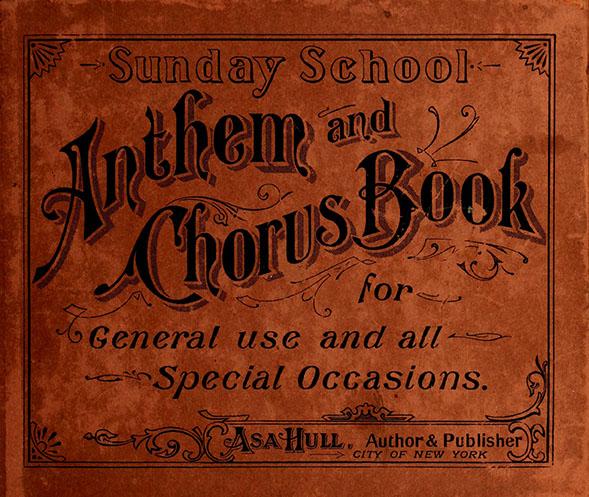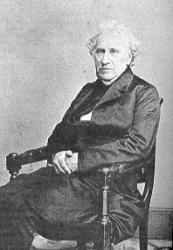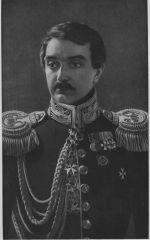Planning worship?
Check out our sister site, ZeteoSearch.org,
for 20+ additional resources related to your search.
- |
User Links
Search Results
Sunday School Anthem and Chorus Book

Publication Date: 1901 Publisher: Asa Hull Publication Place: New York Editors: Asa Hull; Asa Hull
Sunday School Anthem and Chorus Book
The Riven Rock
Author: Mary D. James Appears in 6 hymnals First Line: Behold the Rock, the smitten Rock! Refrain First Line: Oh, the Rock, the Rock, the riven Rock! Used With Tune: [Behold the Rock, the smitten Rock!]
The Riven Rock
Marching to the Land Above
Author: Mrs. W. W. Savage Appears in 21 hymnals First Line: We are marching to a land above Refrain First Line: We are marching to the land above Used With Tune: [We are marching to a land above]
Marching to the Land Above
[Holy, Holy, Holy! Lord God Almighty!]
Appears in 1,065 hymnals Composer and/or Arranger: John B. Dykes Incipit: 11335 56666 53555 Used With Text: Holy, Lord God Almighty
[Holy, Holy, Holy! Lord God Almighty!]
[All for Jesus! all for Jesus!]
Appears in 168 hymnals Composer and/or Arranger: Asa Hull Incipit: 33332 35322 55423 Used With Text: All for Jesus
[All for Jesus! all for Jesus!]
[By cool Siloam's shady rill]
Appears in 233 hymnals Composer and/or Arranger: I. B. Woodbury Incipit: 34536 53132 23532 Used With Text: Siloam
[By cool Siloam's shady rill]
Prayer for Peace
Author: Henry F. Chorley Hymnal: SSAC1901 #3 (1901) First Line: God, the all-terrible! Thou who ordainest Languages: English Tune Title: [God, the all-terrible! Thou who ordainest]
Prayer for Peace
The Mighty March
Author: L. E. Russell Hymnal: SSAC1901 #4 (1901) First Line: Conq'ring God, go forth in glory Refrain First Line: Raise the anthem high as heaven Languages: English Tune Title: [Conq'ring God, go forth in glory]
The Mighty March
Stand Fast
Author: Wm. Bennett Hymnal: SSAC1901 #5 (1901) First Line: Stand fast for God, though all alone Refrain First Line: Stand fast, stand fast Languages: English Tune Title: [Stand fast for God, though all alone]
Stand Fast
Mary Ann Baker
1832 - 1925 Person Name: M. A. Baker Hymnal Number: 194 Author of "Peace, be Still" in Sunday School Anthem and Chorus Book Baker, Mary A.. Miss Baker, who is a member of the Baptist denomination, and a resident in Chicago, Illinois, is an active worker in the temperance cause, and the author of various hymns and temperance songs. Her most popular hymn:-—
1. Master, the tempest is raging, Peace, was written in 1874 at the request of Dr. H. R. Palmer, who desired of her several songs on the subjects of a series of Sunday School Lessons for that year. Its theme is "Christ stilling the tempest." During the same year it was set to music by Dr. Palmer, and pub. in his Songs of Love for the Bible School, 1874. It is found in other collections, including I. D. Sankey's Sacred Songs and Solos, London, 1881. Its home popularity was increased by its republication and frequent use during the illness of Pres. Garfield. It was sung at several of the funeral services held in his honour throughout the States.
2. Why perish with cold and with hunger? Invitation. This is another of her hymns set to music by I. D. Sankey, and included in his Sacred Songs and Solos, Lond., 1881.
--John Julian, Dictionary of Hymnology (1907)
_______
Mary Ann Baker (sometimes known as Mary Eddy Baker), daughter of Joshua Baker and Catherine Eddy, was born 16 Sept. 1832 in Orwell, Oswego, NY. As a young child, her family moved to Branch County, Michigan. Her father died there in 1839 at age 39. A few years later, in 1843, her mother married David Ripley and had two more children, but by 1850, her mother was a single parent again with five children, living in Kinderhook, Branch, Michigan. By 1855, her mother had remarried to Ephraim Potter, and they were living in Boonville, Oneida, New York. In 1860, she and her sister Rhoda Ripley were living in Kalamazoo, Michigan, where she found work as a compositor. Some time between 1867 and 1868 (her sister Rhoda married George Ely in 1868 in Kalamazoo), she moved to Chicago, where she similarly worked as a compositor for Horton & Leonard. While in Chicago, she met composer Horatio R. Palmer and was associated with the Second Baptist Church. In 1900, she was still living in Chicago. Mary never married. In her final years, she was living in the Baptist Old People's Home in nearby Maywood, Cook County, Illinois, where she died at age 93 on 29 Sept. 1925.
by Chris Fenner, 14 Feb. 2022
Mary Ann Baker
William Augustus Muhlenberg

1796 - 1877 Person Name: Dr. Muhlenburg Hymnal Number: 223 Author of "Give Thanks, all ye People" in Sunday School Anthem and Chorus Book Mühlenberg, William Augustus, D.D., son of the Rev. Dr. Mühlenberg, and grandson of Henry Melchior Mühlenberg, the patriarch of Lutheranism in America, was born in Philadelphia Sept. 16, 1796. He graduated at the University of Pennsylvania in 1814. Entering Holy Orders in 1817, he was successively Assistant Rector of St. James's Lancaster, 1823; Rector of the Church of the Holy Communion, New York, 1843; St. Paul's College, Flushing (1828); St. Luke's Hospital, New York (1855); St. John's and Long Island (1865), were established by him. He died April 6, 1877. His poetical gift was genuine, but not largely used. In 1826 he contributed four hymns to the Prayer Book Collection (of which he was one of the Committee). His Poems appeared in 1859. He had previously published Church Poetry, 1823; and The People's Psalter, 1858. I would not live alway followed in 1859 (revised in 1871). This last contains 26 pieces, the hymns in the Prayer Book Collection, 1826, with the exception of "I would not live alway," being omitted. The following are his principal lyrics:—
1. Carol, brothers, carol. Christmas Carol. "Made for the boys of St. Paul's College—-the Chorus adapted from one of the Rev.[Bishop] A.C. Coxe's Christian Ballads"-—in 1840.
2. How short the race our friend has run. Death of a Young Person. Contributed to the Prayer Book Collection, 1826.
3. I would not live alway. Eternal rest desired. Four texts of this poem are extant: 1st the Original; 2nd the version given in the Prayer Book Collection, 1826; 3rd the author's revised version of 1859; and 4th his rewritten text of 1871, the second of these being that known to the hymnbooks. The history of the poem is somewhat complicated. We quote it here as given by us in the History of the American Episcopal Church, 1885, p.637, as we have nothing further to add thereto:-—
"The most famous of these (Dr. Mühlenberg's hymns) was probably first written. 'I will not live alway' has an intricate history, which was not simplified by the author's lapse of memory in his later years. In his brief ‘story of the hymn,' printed with its ‘evangelized’ text in 1871, every date is wrong by two or three years; and his assertion, ‘The legend that it was written on an occasion of private grief is a fancy,' hardly agrees with the clear and minute recollections of persons of the highest character, still living, and who knew the circumstances thoroughly. The date of composition assigned, 1824, is probably (not certainly) correct; it was written at Lancaster, in a lady's album, and began:—
I would not live alway; no, no, holy man,
Not a day, not an hour, should lengthen my span.'
In this shape it seems to have had six eight-line stanzas. The album was still extant in 1876, at Pottstown, Pa., and professed to contain the original manuscript. Said the owner's sister, ‘It was au impromptu. He had no copy, and, wanting it for some occasion, he sent for the album.' In 1826 he entrusted his copy to a friend, who called on him on the way from Harrisburg to Philadelphia, to carry to the Episcopal Recorder, and in that paper it appeared June 3, 1826 (not 1824). For these facts we have the detailed statement of Dr. John B. Clemson, of Claymont, Del., the Ambassador mentioned, who also chances to have preserved that volume of the paper. Thus appearing (without name) it was adopted by the sub-committee [of the Prayer Book Collection, 1826]. When their report was presented to the entire committee in 1826—-not 1829, as Dr. Mühlenberg had it—-'each of the hymns was passed upon. When this came up one of the members remarked that it was very sweet and pretty, but rather sentimental, upon which it was unanimously thrown out. Not suspected as the author, I voted against myself. That, I supposed, was the end of it.’ The committee, which sat until late at night at the house of Bishop White, agreed upon their report to the Convention, and adjourned. But the next morning Dr. Onderdonk (who was not one of their number, but who, on invitation, had acted with the sub-committee, which in fact consisted of him and myself), called on me to inquire what had been done. Upon my telling him that among the rejected hymns was this one of mine, he said, 'That will never do,' and went about among the members of the committee soliciting them to restore the hymn in their report, which accordingly they did; so that to him is due the credit of giving it to the Church.' As thus adopted it was a small and altered selection from the original lines, made by Dr. Onderdonk ‘with some revision' by the author. He was never satisfied with these texts, but revised the poem in 1859, and re¬wrote it in 1871….The authorship of this, as of many another popular lyric, has been disputed. The claim of Henry Ward, a printer of Lichfield, Conn., has been vehemently urged, and revived but a few years ago. Of course it is unsupported by adequate evidence. When Dr. Mühlenberg was asked to assure ‘some of his brethren, editors of Church papers,' of his paternity, his manly reply was, ‘If they thought I was capable of letting the work of another pass for so many years as my own, they would not be sure of anything I might say.'"
4. Jesus' Name shall ever be. The Holy Name, Jesus. This is entitled "The Blessed Name of Jesus. An Evangelical Rosary." It was written in 1842, and revised for Schaff's Christ in Song in Aug., 1868.
5. King of kings, and wilt Thou deign. Submission to Jesus. Appeared in his Poems, 1859.
6. Like Noah's weary dove. The Ark of the Church. Contributed to the Prayer Book Collection, 1826, No. 24, in 5 st. of 4 1. It sometimes begins with st. ii., "0 cease, my wandering soul;" and again with st. in., "Behold the Ark of God."
7. Saviour, Who Thy flock art feeding. Holy Baptism. This is the most widely known of Dr. Mühlenberg's hymns. It was contributed to the Prayer Book Collection, 1826, No. 86, in 4 st. of 4 1. It is sometimes given as "Jesus, Who Thy flock art feeding."
8. Shout the glad tidings, exultingly sing. Christmas. Contributed to the Prayer Book Collection, 1826, No. 46, in 3 st. of 4 1., with the chorus :—
"Shout the glad tidings, exultingly sing,
Jerusalem triumphs, Messiah is King;"
the opening lines, followed by the first stanza, and a repetition of the chorus, and so on to the end. Sometimes the hymn opens with st. i.: "Zion, the marvellous story be telling," or as “Sion the marvellous story be telling," instead of the chorus. Dr. Mühlenberg says that the hymn was written—
"at the particular request of Bishop Hobart, who wanted something that would go to the tune by Avison, then popular, to the words of Moore, ‘Sound the loud timbrel,' &c. He liked the verses I made so well that he had them struck off before the hymns (Prayer Book Collection] were published, and sung in Trinity Church on Christmas day."
9. Since o'er Thy footstool here below. Earth and Heaven. Appeared in the Episcopal Register, 1824, and in his Poems, 1859.
10. The mellow eve is gliding. Evening. Dated 1825 (?) and published in his Poems, 1859.
11. The throne of his glory—-as snow it is white. Advent. Dated 1839, and published in his Poems, 1859.
12. Thine handmaid,Saviour, can it be? Admission of a Nursing Sister. Written on the words, "Come, follow me," for the reception of a Sister at St. Luke's Hospital, New York, 1859.
[Rev. F. M. Bird, M.A.]
--John Julian, Dictionary of Hymnology (1907)
See also in:
Hymn Writers of the Church
William Augustus Muhlenberg
Aleksēi Federovich L'vov

1798 - 1870 Person Name: Alexis D. Lwoff Hymnal Number: 3 Composer of "[God, the all-terrible! Thou who ordainest]" in Sunday School Anthem and Chorus Book Alexis Federovich L’vov Estonia 1798-1870. Born at Reval, Estonia, son of the St. Petersburg imperial court chapel director, he learned violin as a child and gave regular concerts in his home at age 9. Studying under a number of teachers until age 19, he then studied independently and developed his own personal style of playing. He entered the Russian army in 1818, became a civil engineer there eventually a General in 1828, when he was appointed Aide-de-camp to Tsar Nicholas I. He married Praskovya Aggeyevna, and they had a son and two daughters. He eventually took over his father’s post after he died in 1837 and stayed at that position for 24 years. He formed a string quartet in St. Petersburg and held weekly concerts at his private residence, which were attended by members of high society, including Franz Liszt, Robert and Clara Schumann, and Berlioz. In charge of the Russian chapel choir, it was described by Berlioz as of exceptional quality, expressing regret that Europeans were unable to hear the extraordinary sounds of the chapel choir (80 singers). L’vov took his quartet on several European tours where he could play to public audiences. He met Mendelssohn, Meyerbeer, and Spontini, who became personal friends. L’vov codified the Russian liturgical musical style ‘Obikhod’, the standard repertory of most Russian Orthodox churches in the world. L’vov was a member of the Russian musical establishment. Two of his friends who attained musical fame were Glinka and Berlioz, both impressed with L’vov’s superb violin playing and composing abilities. He composed violin music, operas and various religious pieces. His opera “Undine” (1846) became famous. In 1850 he founded the Russian Concert Society. His musical style was eclectic, combining traditions of Russian culture with Italian and German influences. He retired in 1867 due to deafness. He died near Kovno, Lithuania.
John Perry
Aleksēi Federovich L'vov


 My Starred Hymns
My Starred Hymns


